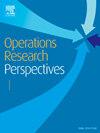预算不确定性下优先级递减的鲁棒斯坦纳团队定向问题
IF 3.7
4区 管理学
Q2 OPERATIONS RESEARCH & MANAGEMENT SCIENCE
引用次数: 0
摘要
在过去的十年里,灾后救援工作受到了人们的关注,重点是提高劳动力和社会环境的复原力。这项工作引入了鲁棒斯坦纳团队定向问题与降低优先级(R-STOP-DP)来模拟紧急救援行动,其中几个地点可能需要救援航天飞机,但确切的需求无法预见。R-STOP-DP是具有位置优先级的车辆路线问题的一种变体,它应用鲁棒优化来模拟由于访问位置而引起的服务时间的变化。地点被细分为强制性和可选性,后者与随时间线性减少的优先级相关。目标是在考虑不确定预算和路线持续时间限制的最坏情况下,找到最大限度地提高所收集的优先级的鲁棒可行路线。我们提出了两个紧凑的公式-通过从文献中改编的有效不等式加强-并以切割和分支的方式解决它们。此外,我们还提出了一种核搜索启发式算法和模拟退火启发式算法。计算实验表明一个公式的严格优势,在360个测试实例中平均提高了12.29%的对偶边界。基于更强模型的切断和分支算法也很突出,比其他算法多解决了20个实例。模拟退火启发式算法在平均2.52秒的执行时间内,通过改进和/或达到完整基准的最知名界限,获得了显着的性能。反过来,内核搜索算法在平均运行时间的4.5分钟内达到或改进了81%的实例的边界。本文章由计算机程序翻译,如有差异,请以英文原文为准。
The Robust Steiner Team Orienteering Problem with Decreasing Priorities under budgeted uncertainty
Post-disaster relief operations have gained attention over the past decade, focusing on enhancing resilience in labor and social environments. This work introduces the Robust Steiner Team Orienteering Problem with Decreasing Priorities (R-STOP-DP) to model emergency rescue operations where several locations might need relief shuttles, but exact demands cannot be foreseen. R-STOP-DP is a variation of the vehicle routing problem with location priorities that applies robust optimization to model the variability on service times incurred by visiting locations. Locations are sub-divided into mandatory and optional, being the latter linked to priorities that linearly decrease over time. The goal is to find robust feasible routes maximizing the priorities collected, while considering the worst-case conditions of service times within an uncertainty budget and a routes’ duration limit. We propose two compact formulations – reinforced by valid inequalities adapted from the literature – and solve them in a cut-and-branch fashion. In addition, we propose a kernel search mat-heuristic and a simulated annealing heuristic. Computational experiments suggest the strict dominance of one formulation, improving dual bounds by 12.29% on average over the 360 instances tested. The cut-and-branch algorithm based on the stronger model also stands out, solving 20 more instances than the other. The simulated annealing heuristic obtains a remarkable performance by improving over and/or reaching the best-known bounds for the complete benchmark, within an average execution time of 2.52 s. In turn, the kernel search mat-heuristic reaches or improves the bounds for 81% of the instances within 4.5 min of average running time.
求助全文
通过发布文献求助,成功后即可免费获取论文全文。
去求助
来源期刊

Operations Research Perspectives
Mathematics-Statistics and Probability
CiteScore
6.40
自引率
0.00%
发文量
36
审稿时长
27 days
 求助内容:
求助内容: 应助结果提醒方式:
应助结果提醒方式:


